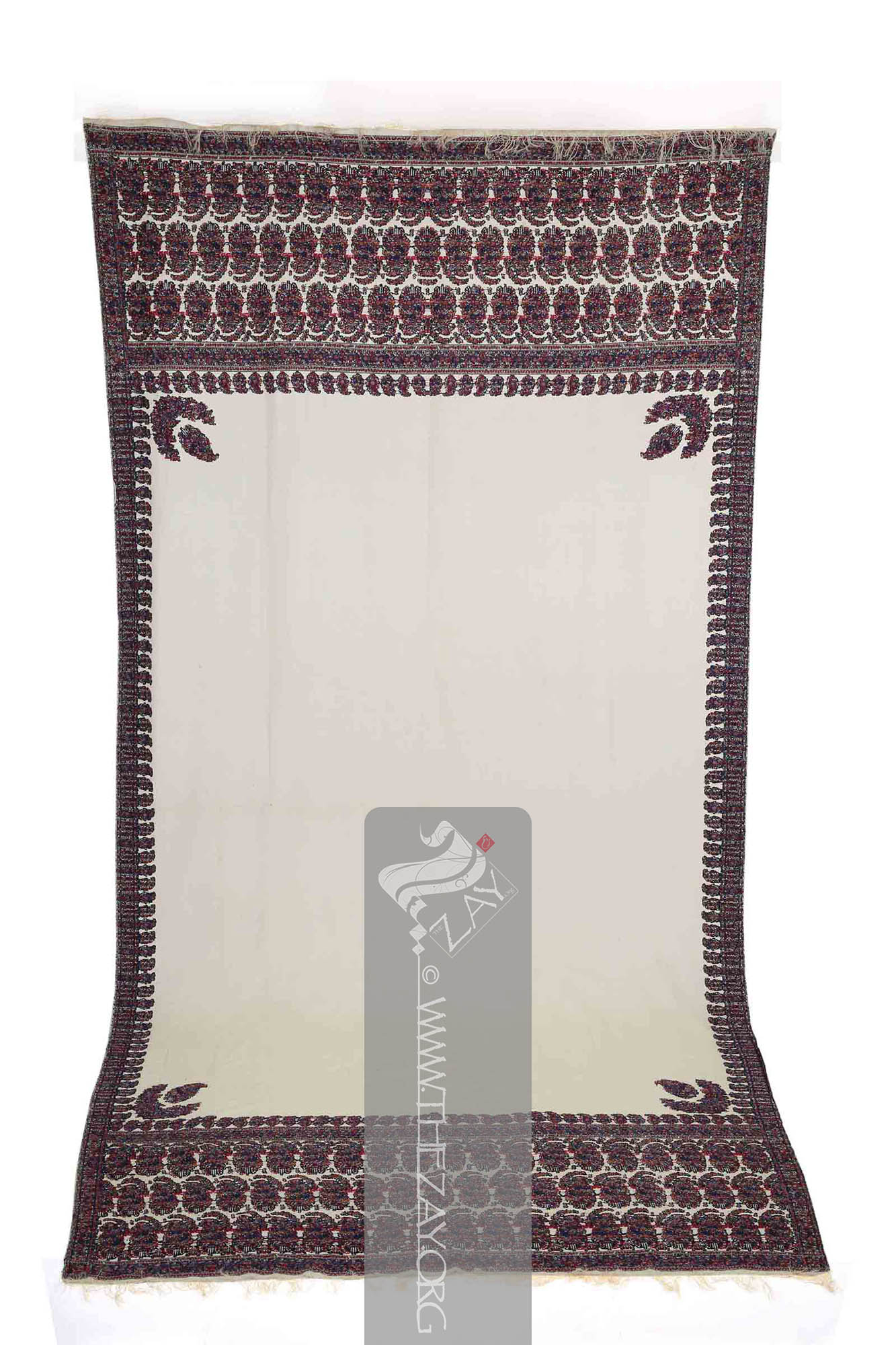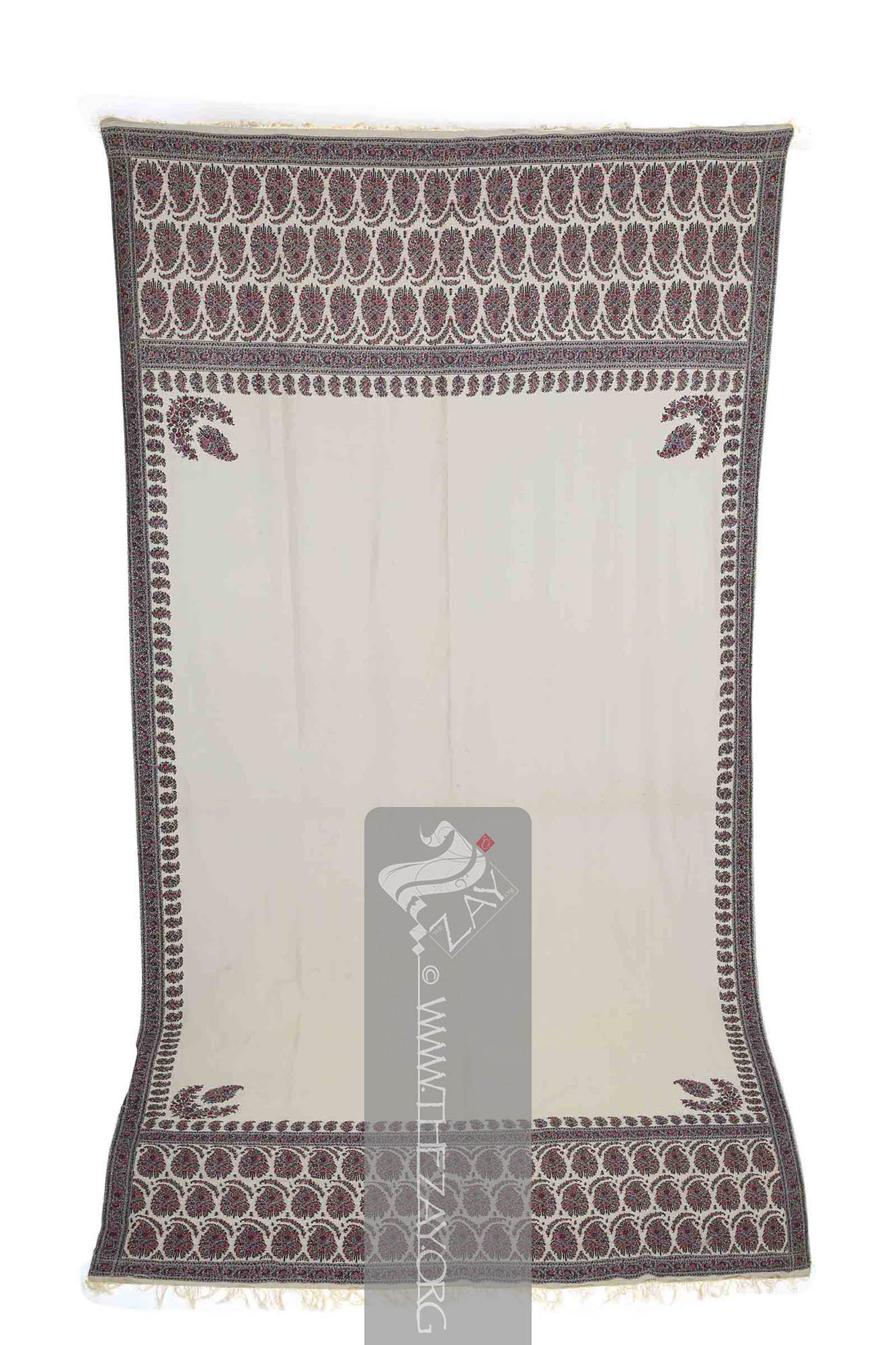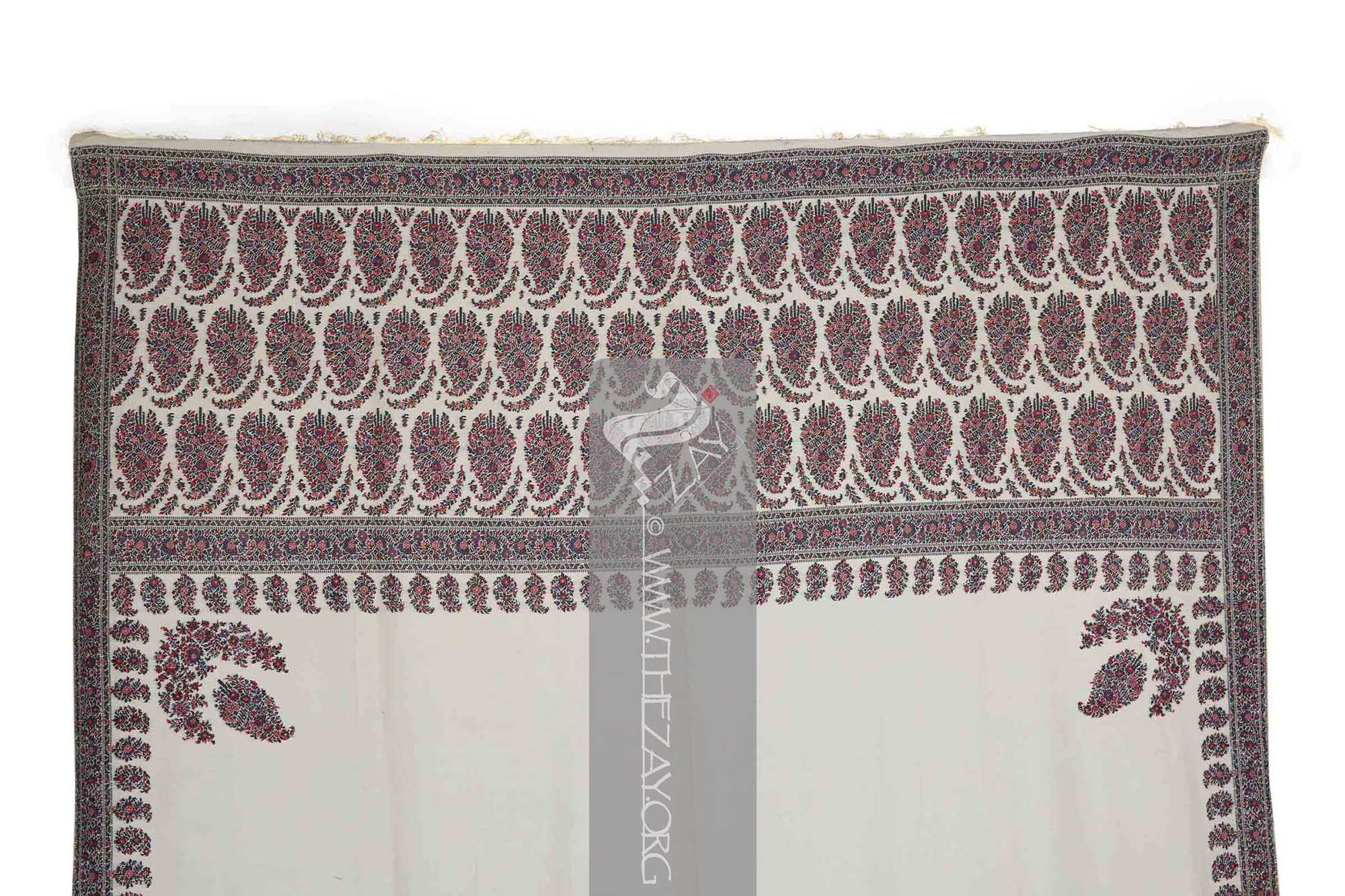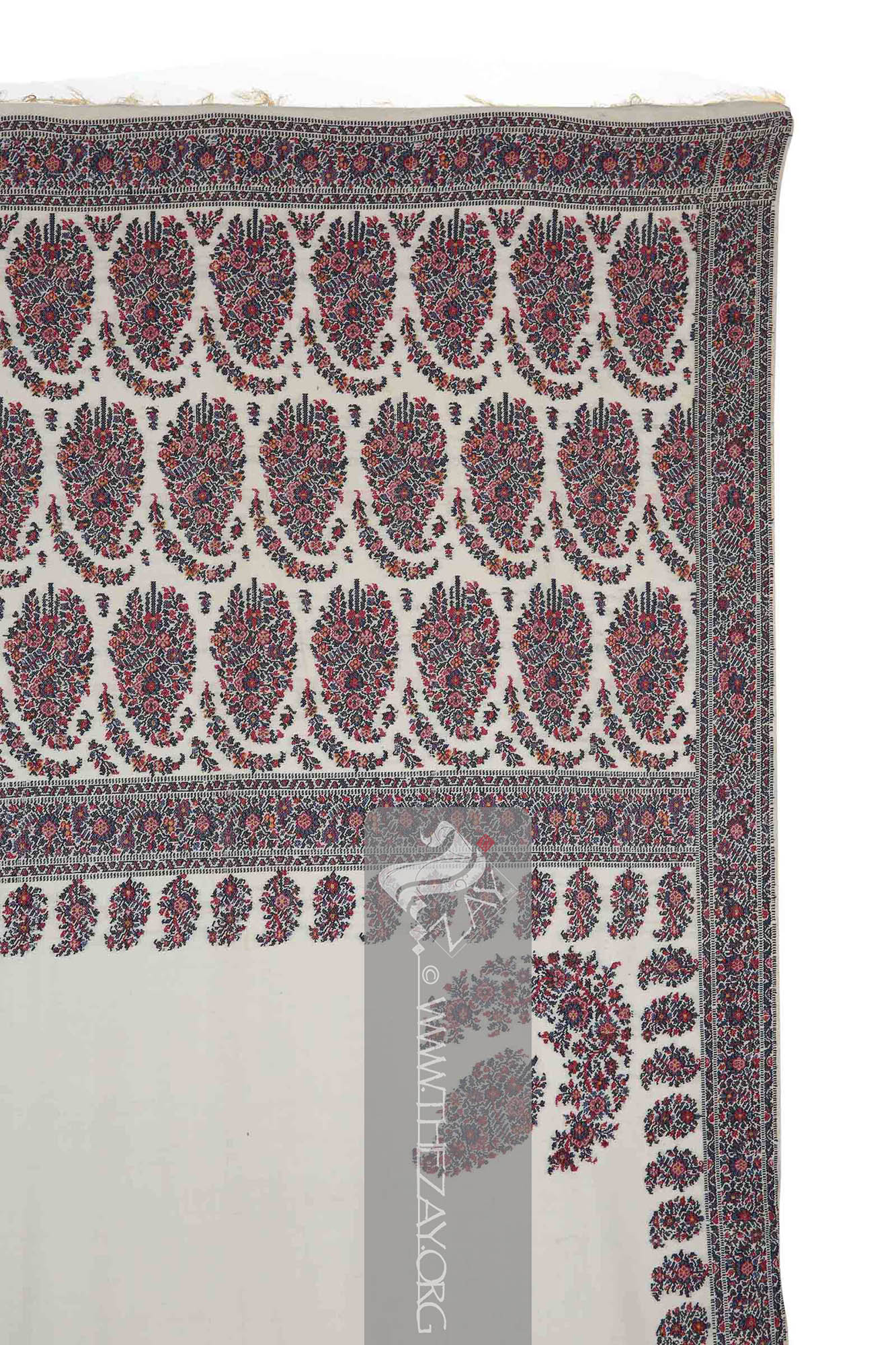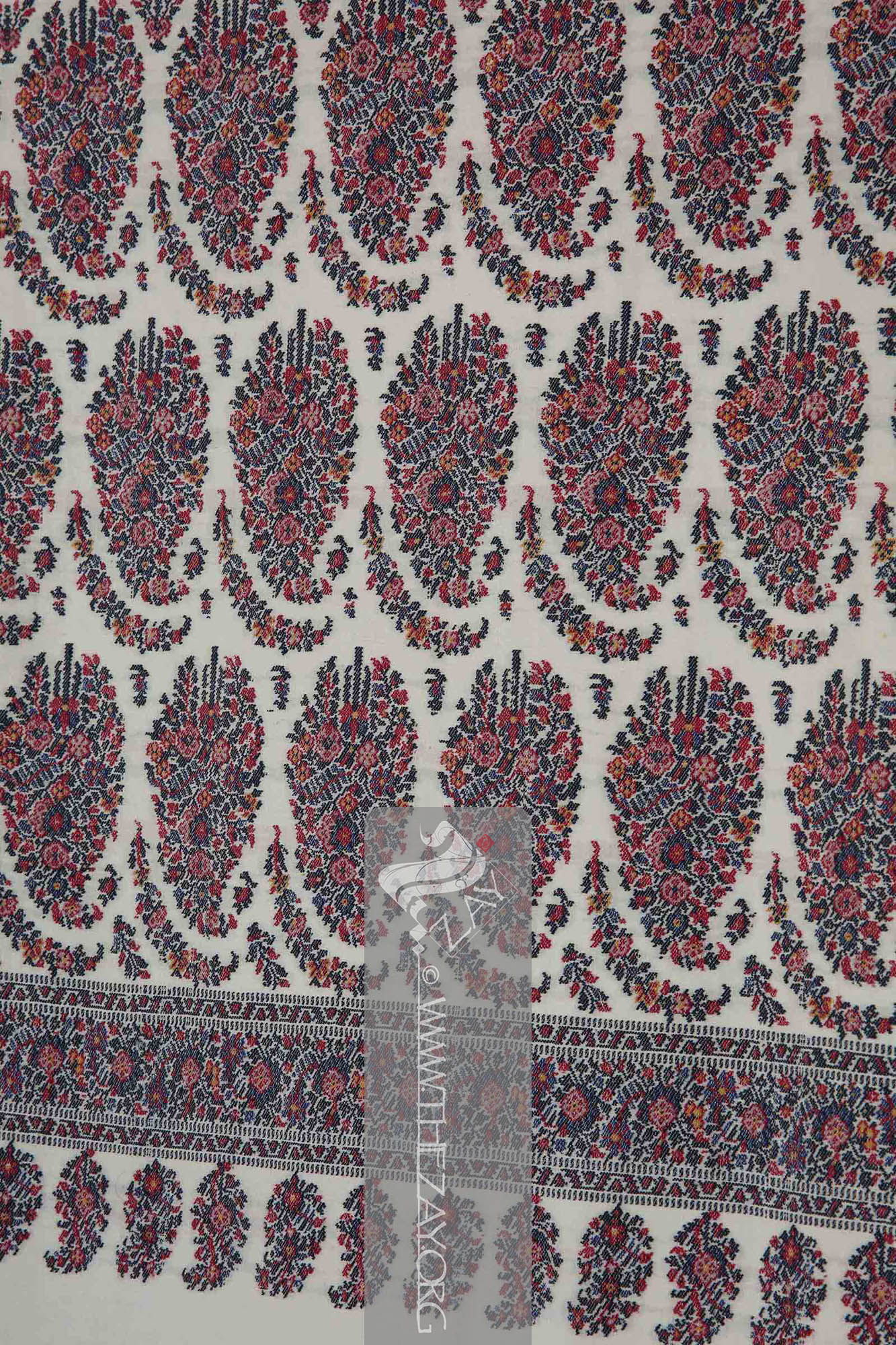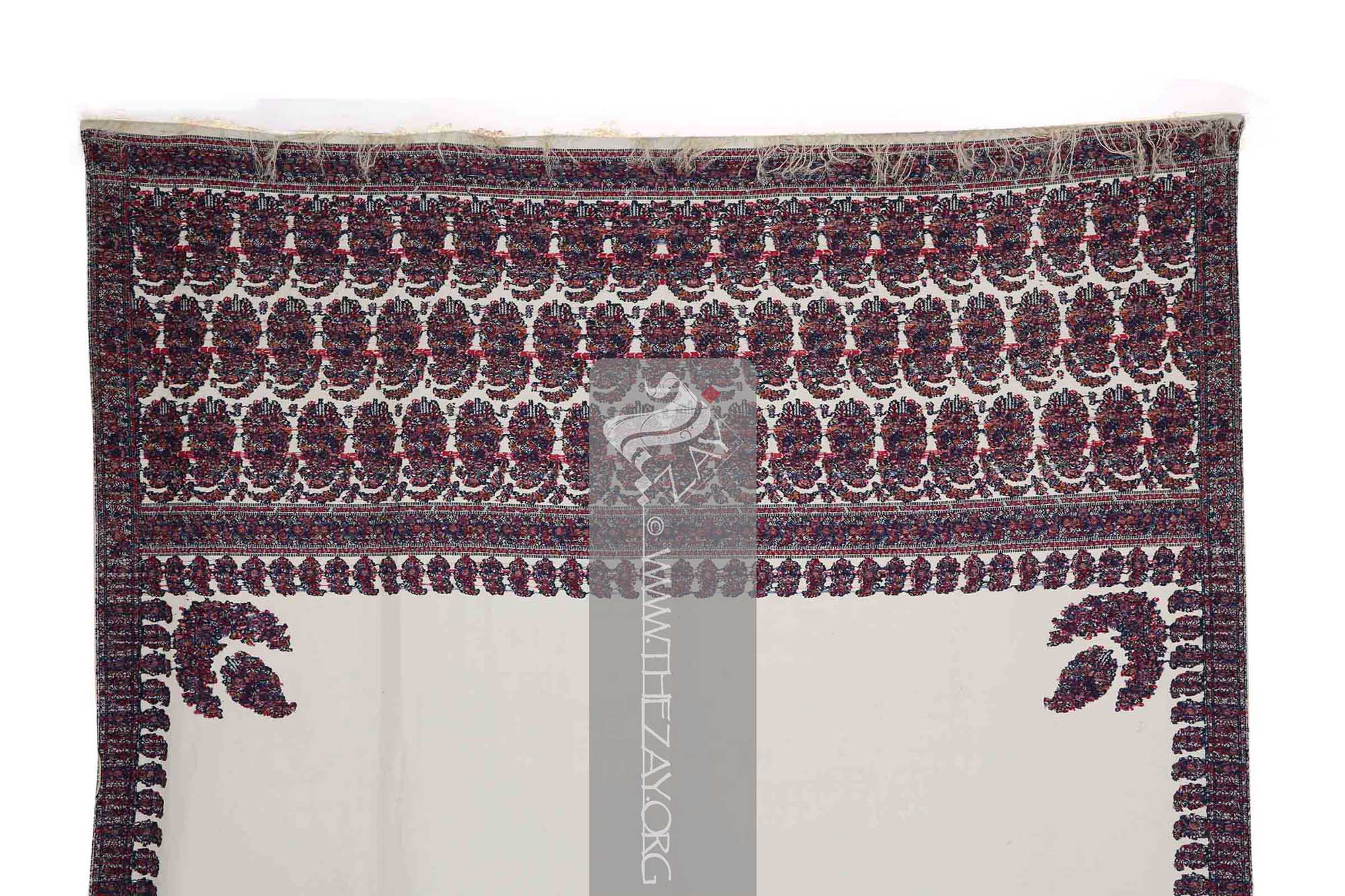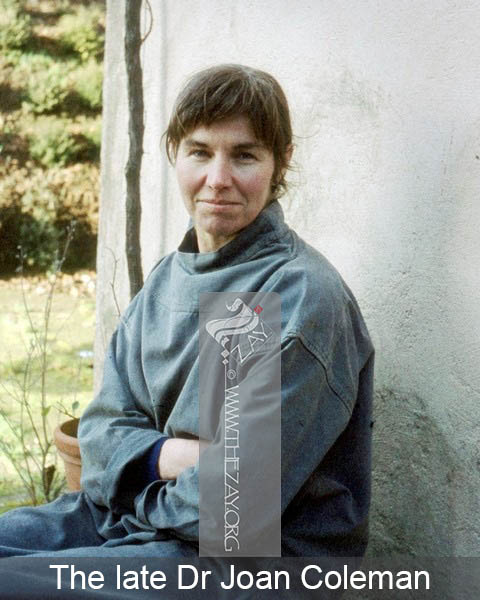Object HistoryThis ivory long
shawl
Shawl: (Persian: shāl from Hindi: duśālā – Shoulder Mantle), a shawl is a South Asian version of a scarf worn or wrapped loosely over the shoulders and is usually made of wool. , possibly from
Paisley
Paisley: (Scottish Gaelic, Pàislig: a town in Scotland), often called buta, boteh, amli, or kalgi in the subcontinent and kazuwah in Arabic, is a Persian tear drop motif with a curved end specially in textiles. Its popularity and subsequent local production in 18th century at Paisley are responsible for its nomenclature., Scotland dating back to the early 19th century was originally a part of the Dr Joan Coleman Collection. It was first purchased at a Christies’s auction in London on October 27, 1977. Later The
Zay
Zay: (Arabic: costume, Pl. azyaā’), a set of clothes in a style typical of a particular country or historical period. Initiative managed to acquire it from Kerry Taylor Auctions in the year 2020.
Dr Joan Coleman began collecting shawls in 1976 and developed her lifelong passion for collecting. She was a regular at the London salesrooms of Christie’s, Sotheby’s, and Phillips – three of the most outstanding auction houses of the period in the world – getting to know the dealers and learning in the process. She acquired vast knowledge and dedicated hours carefully cataloguing her ever-growing collection. She intended to loan her collection to different museums and institutions for the benefit of learning and education. Her collection is one of the largest and the finest private
shawl
Shawl: (Persian: shāl from Hindi: duśālā – Shoulder Mantle), a shawl is a South Asian version of a scarf worn or wrapped loosely over the shoulders and is usually made of wool. collections to have ever graced the world with shawls ranging from Kashmir,
Paisley
Paisley: (Scottish Gaelic, Pàislig: a town in Scotland), often called buta, boteh, amli, or kalgi in the subcontinent and kazuwah in Arabic, is a Persian tear drop motif with a curved end specially in textiles. Its popularity and subsequent local production in 18th century at Paisley are responsible for its nomenclature., Edinburgh, Norwich, France, and Iran.
Object Features This is a long
shawl
Shawl: (Persian: shāl from Hindi: duśālā – Shoulder Mantle), a shawl is a South Asian version of a scarf worn or wrapped loosely over the shoulders and is usually made of wool. or (
kirking_shawl
Kirking_shawl: (Scottish: Kirk from Old English: cirice – Church; Synonym: Long Shawl
Shawl: (Persian: shāl from Hindi: duśālā – Shoulder Mantle), a shawl is a South Asian version of a scarf worn or wrapped loosely over the shoulders and is usually made of wool. ), European versions of and inspired by Kashmiri double shawl
Shawl: (Persian: shāl from Hindi: duśālā – Shoulder Mantle), a shawl is a South Asian version of a scarf worn or wrapped loosely over the shoulders and is usually made of wool. s in wool or silk manufactured locally in Europe. As a part of the trousseau for aristocratic women, it was often used at their first post-wedding church services and christenings. ) dating back to the early 19th century – c.1820-1830 – that was possibly manufactured in the town of
Paisley
Paisley: (Scottish Gaelic, Pàislig: a town in Scotland), often called buta, boteh, amli, or kalgi in the subcontinent and kazuwah in Arabic, is a Persian tear drop motif with a curved end specially in textiles. Its popularity and subsequent local production in 18th century at Paisley are responsible for its nomenclature., Scotland. This elegant rectangular (
shawl
Shawl: (Persian: shāl from Hindi: duśālā – Shoulder Mantle), a shawl is a South Asian version of a scarf worn or wrapped loosely over the shoulders and is usually made of wool. ) is made of ivory silk in (
satin
Sātin: (Arabic: Zaytuni: from Chinese port of Zayton in Quanzhou province where it was exported from and acquired by Arab merchants), one of the three basic types of woven fabric with a glossy top surface and a dull back. Originated in China and was fundamentally woven in silk.) weave. It has a woven border in vibrant combinations of yellow, (
indigo
Indigo: (Latin: Indigo – India, synonym: nil
Nīl: (Latin: indigo), Arabised term for Indigo, a natural dye belonging to the ‘Indigofera Tinctoria’ species of plants that have been cultivated in East Asia, Egypt, India, and Peru since antiquity. According to Pliny the Elder, it was named after India as it was the source of the dye.), a natural dye belonging to the ‘Indigofera Tinctoria’ species of plants that has been cultivated in East Asia, Egypt, India, and Peru since antiquity. According to Pliny the Elder, it was named after India as it was the source of the dye. ) blue, and red. The running woven border in woollen (
weft
Weft: one of the two basic components used in weaving that transforms thread or yarns into a piece of fabric. It is the crosswise thread on a loom that is passed over and under the warp threads.) threads stands testament to its origin in a (
jacquard
Jacquard: (After Joseph M Jacquard a French weaver and inventor), is referred to both an apparatus with perforated cards invented by the aforementioned Joseph M Jacquard in 1804 fitted to a loom enabling complex intricate weaving patterns and the brocaded fabric woven on a jacquard loom. ) loom.
The
shawl
Shawl: (Persian: shāl from Hindi: duśālā – Shoulder Mantle), a shawl is a South Asian version of a scarf worn or wrapped loosely over the shoulders and is usually made of wool. has a (
phala
Phāla: (Etymological origin: Possibly Indo Persian), the wider layer of pattern that forms the border at each warp
Warp: One of the two basic components used in weaving which transforms thread or yarns to a piece of fabric. The warp is the set of yarns stretched longitudinally in place on a loom before the weft
Weft: one of the two basic components used in weaving that transforms thread or yarns into a piece of fabric. It is the crosswise thread on a loom that is passed over and under the warp threads. is introduced during the weaving process. end or head of a shawl
Shawl: (Persian: shāl from Hindi: duśālā – Shoulder Mantle), a shawl is a South Asian version of a scarf worn or wrapped loosely over the shoulders and is usually made of wool. . ) one on each end with three rows of medium size (
buta
Būta: (Anglicized Persian: boteh – Pinecone shaped motif), known as paisley
Paisley: (Scottish Gaelic, Pàislig: a town in Scotland), often called buta, boteh, amli, or kalgi in the subcontinent and kazuwah in Arabic, is a Persian tear drop motif with a curved end specially in textiles. Its popularity and subsequent local production in 18th century at Paisley are responsible for its nomenclature. in English it is the almond or pinecone-shaped motif, especially in textiles. It is believed to have originated from the Cyprus tree a Zoroastrian symbol for life and eternity. In the current Indian context, however, it simply means motif.) / (
paisley
Paisley: (Scottish Gaelic, Pàislig: a town in Scotland), often called buta, boteh, amli, or kalgi in the subcontinent and kazuwah in Arabic, is a Persian tear drop motif with a curved end specially in textiles. Its popularity and subsequent local production in 18th century at Paisley are responsible for its nomenclature.) each of them bracketed by an arched floral vine. Each row has twenty
buta
Būta: (Anglicized Persian: boteh – Pinecone shaped motif), known as paisley
Paisley: (Scottish Gaelic, Pàislig: a town in Scotland), often called buta, boteh, amli, or kalgi in the subcontinent and kazuwah in Arabic, is a Persian tear drop motif with a curved end specially in textiles. Its popularity and subsequent local production in 18th century at Paisley are responsible for its nomenclature. in English it is the almond or pinecone-shaped motif, especially in textiles. It is believed to have originated from the Cyprus tree a Zoroastrian symbol for life and eternity. In the current Indian context, however, it simply means motif. with ten facing left and ten right with the exception of middle row where the two middle
buta
Būta: (Anglicized Persian: boteh – Pinecone shaped motif), known as paisley
Paisley: (Scottish Gaelic, Pàislig: a town in Scotland), often called buta, boteh, amli, or kalgi in the subcontinent and kazuwah in Arabic, is a Persian tear drop motif with a curved end specially in textiles. Its popularity and subsequent local production in 18th century at Paisley are responsible for its nomenclature. in English it is the almond or pinecone-shaped motif, especially in textiles. It is believed to have originated from the Cyprus tree a Zoroastrian symbol for life and eternity. In the current Indian context, however, it simply means motif. are not full, but half merged back-to-back with the other giving it the shape of a Roman ancient Greek vase or amphora. The presence of multiple
buta
Būta: (Anglicized Persian: boteh – Pinecone shaped motif), known as paisley
Paisley: (Scottish Gaelic, Pàislig: a town in Scotland), often called buta, boteh, amli, or kalgi in the subcontinent and kazuwah in Arabic, is a Persian tear drop motif with a curved end specially in textiles. Its popularity and subsequent local production in 18th century at Paisley are responsible for its nomenclature. in English it is the almond or pinecone-shaped motif, especially in textiles. It is believed to have originated from the Cyprus tree a Zoroastrian symbol for life and eternity. In the current Indian context, however, it simply means motif. on the
phala
Phāla: (Etymological origin: Possibly Indo Persian), the wider layer of pattern that forms the border at each warp
Warp: One of the two basic components used in weaving which transforms thread or yarns to a piece of fabric. The warp is the set of yarns stretched longitudinally in place on a loom before the weft
Weft: one of the two basic components used in weaving that transforms thread or yarns into a piece of fabric. It is the crosswise thread on a loom that is passed over and under the warp threads. is introduced during the weaving process. end or head of a shawl
Shawl: (Persian: shāl from Hindi: duśālā – Shoulder Mantle), a shawl is a South Asian version of a scarf worn or wrapped loosely over the shoulders and is usually made of wool. . is meticulously balanced by the absence of a significant (
jaal
Jaal: (Sanskrit: jaal – A net, web, or a mesh), the decoration which fills the ground between the paisley
Paisley: (Scottish Gaelic, Pàislig: a town in Scotland), often called buta, boteh, amli, or kalgi in the subcontinent and kazuwah in Arabic, is a Persian tear drop motif with a curved end specially in textiles. Its popularity and subsequent local production in 18th century at Paisley are responsible for its nomenclature. cones at the heads of a shawl
Shawl: (Persian: shāl from Hindi: duśālā – Shoulder Mantle), a shawl is a South Asian version of a scarf worn or wrapped loosely over the shoulders and is usually made of wool. .
). The (
tanjir
Tanjīr: (Possibly Persian: zanjir: Chain), a narrow layer of pattern that forms the border and runs above and below the wider layer. ) are composed of red floral motifs intertwined across an
indigo
Indigo: (Latin: Indigo – India, synonym: nil
Nīl: (Latin: indigo), Arabised term for Indigo, a natural dye belonging to the ‘Indigofera Tinctoria’ species of plants that have been cultivated in East Asia, Egypt, India, and Peru since antiquity. According to Pliny the Elder, it was named after India as it was the source of the dye.), a natural dye belonging to the ‘Indigofera Tinctoria’ species of plants that has been cultivated in East Asia, Egypt, India, and Peru since antiquity. According to Pliny the Elder, it was named after India as it was the source of the dye. blue vine with highlights of yellow. The same design is repeated on a slightly narrower (hashiya).
Although the body of the
shawl
Shawl: (Persian: shāl from Hindi: duśālā – Shoulder Mantle), a shawl is a South Asian version of a scarf worn or wrapped loosely over the shoulders and is usually made of wool. is plain ivory which is typical of a
Kirking_shawl
Kirking_shawl: (Scottish: Kirk from Old English: cirice – Church; Synonym: Long Shawl
Shawl: (Persian: shāl from Hindi: duśālā – Shoulder Mantle), a shawl is a South Asian version of a scarf worn or wrapped loosely over the shoulders and is usually made of wool. ), European versions of and inspired by Kashmiri double shawl
Shawl: (Persian: shāl from Hindi: duśālā – Shoulder Mantle), a shawl is a South Asian version of a scarf worn or wrapped loosely over the shoulders and is usually made of wool. s in wool or silk manufactured locally in Europe. As a part of the trousseau for aristocratic women, it was often used at their first post-wedding church services and christenings. , it has a frame around the hashiya and the
tanjir
Tanjīr: (Possibly Persian: zanjir: Chain), a narrow layer of pattern that forms the border and runs above and below the wider layer. composed of smaller
buta
Būta: (Anglicized Persian: boteh – Pinecone shaped motif), known as paisley
Paisley: (Scottish Gaelic, Pàislig: a town in Scotland), often called buta, boteh, amli, or kalgi in the subcontinent and kazuwah in Arabic, is a Persian tear drop motif with a curved end specially in textiles. Its popularity and subsequent local production in 18th century at Paisley are responsible for its nomenclature. in English it is the almond or pinecone-shaped motif, especially in textiles. It is believed to have originated from the Cyprus tree a Zoroastrian symbol for life and eternity. In the current Indian context, however, it simply means motif.. Forty
buta
Būta: (Anglicized Persian: boteh – Pinecone shaped motif), known as paisley
Paisley: (Scottish Gaelic, Pàislig: a town in Scotland), often called buta, boteh, amli, or kalgi in the subcontinent and kazuwah in Arabic, is a Persian tear drop motif with a curved end specially in textiles. Its popularity and subsequent local production in 18th century at Paisley are responsible for its nomenclature. in English it is the almond or pinecone-shaped motif, especially in textiles. It is believed to have originated from the Cyprus tree a Zoroastrian symbol for life and eternity. In the current Indian context, however, it simply means motif. are lined on the head of the
tanjir
Tanjīr: (Possibly Persian: zanjir: Chain), a narrow layer of pattern that forms the border and runs above and below the wider layer. divided into two halves, each half mirroring the other. A similar pattern follows the hashiya on the two sides too. These lines of paisleys forming a frame is topped with four tilted (
kunjbuta
Kunjbuta: (Sanskrit: kunj – place or corner associated with greenery; and Sanskrit: buta – foliage motif), the word is probably a portmanteau of two Sanskrit words it usually refers to the corner ornaments or decoration on a shawl
Shawl: (Persian: shāl from Hindi: duśālā – Shoulder Mantle), a shawl is a South Asian version of a scarf worn or wrapped loosely over the shoulders and is usually made of wool. . ) one at each corner.
It is important to note that long shawls of similar design distribution were in vogue during this period. With high waistlines, flowing skirts, and (
bodice
Bodice: (English: body), or bodices the plural form of body, it is the close-fitting garment meant to cover the body above the waist or the torso. However, it was not until the 17th century that the term became synonymous to women’s undergarment. ) detailing pintucks and wide puff sleeves of women’s dresses in Great Britain during this time large shawls like this were the perfect accessory for a balanced silhouette. By the 1850s with the widening of skirts and (
crinolines
Crinolines: (Latin: crinis – hair, linum – thread, Synonym – Hoop skirt), a hooped or structured petticoat made of a stiff fabric which is composed of horsehair and cotton or linen thread. It was designed to hold a woman’s skirt out and became popular in the 19th century in Europe and the USA.) frames, these shawls became even more popular as it was difficult to wear a jacket or a coat. This resulted in the inclusion of at least one such
shawl
Shawl: (Persian: shāl from Hindi: duśālā – Shoulder Mantle), a shawl is a South Asian version of a scarf worn or wrapped loosely over the shoulders and is usually made of wool. in the wedding trousseau of every lady from the aristocracy thus giving rise to the term (
kirking_shawl
Kirking_shawl: (Scottish: Kirk from Old English: cirice – Church; Synonym: Long Shawl
Shawl: (Persian: shāl from Hindi: duśālā – Shoulder Mantle), a shawl is a South Asian version of a scarf worn or wrapped loosely over the shoulders and is usually made of wool. ), European versions of and inspired by Kashmiri double shawl
Shawl: (Persian: shāl from Hindi: duśālā – Shoulder Mantle), a shawl is a South Asian version of a scarf worn or wrapped loosely over the shoulders and is usually made of wool. s in wool or silk manufactured locally in Europe. As a part of the trousseau for aristocratic women, it was often used at their first post-wedding church services and christenings. ) especially in Scotland as they were worn to the kirk or church on the first Sunday after the wedding and then again at christenings of children.




